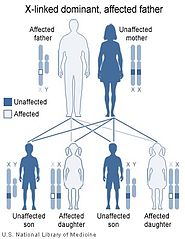Familial hypophosphatemia
| X-linked hypophosphatemia | |
|---|---|
| Caption = X-linked dominant inheritance works differently depending upon whether the mother (left image) or father (right image) is the carrier of a gene that causes a disease or disorder | |
| Classification and external resources | |
| Specialty | endocrinology |
| ICD-10 | E83.3 |
| ICD-9-CM | 275.3 |
| OMIM | 307800 |
| DiseasesDB | 6513 |
| eMedicine | MeshName = |
| MeSH | D053098 |
| Orphanet | 89936 |
X-linked hypophosphatemia (XLH), also called X-linked dominant hypophosphatemic rickets, X-linked vitamin d-resistant rickets, is an X-linked dominant form of rickets (or osteomalacia) that differs from most cases of rickets in that ingestion of vitamin D is relatively ineffective. It can cause bone deformity including short stature and genu varum (bow leggedness). It is associated with a mutation in the PHEX gene sequence (Xp.22) and subsequent inactivity of the PHEX protein. The prevalence of the disease is 1:20000. The leg deformity can be treated with Ilizarov frames and CHAOS surgery.
The presentation of x-linked hypophosphatemia is consistent with:
Dental Presentations:
XLH is associated with a mutation in the PHEX gene sequence, located on the human X chromosome at location Xp22.2-p22.1. The PHEX protein regulates another protein called fibroblast growth factor 23 (produced from the FGF23 gene). Fibroblast growth factor 23 normally inhibits the kidneys' ability to reabsorb phosphate into the bloodstream. Gene mutations in PHEX prevent it from correctly regulating fibroblast growth factor 23. The resulting overactivity of FGF-23 reduces vitamin D 1α-hydroxylation and phosphate reabsorption by the kidneys, leading to hypophosphatemia and the related features of hereditary hypophosphatemic rickets. Also in XLH, where PHEX enzymatic activity is absent or reduced, osteopontin — a mineralization-inhibiting secreted substrate protein found in the extracellular matrix of bone — accumulates in bone (and teeth) to contribute to the osteomalacia (and odontomalacia) as shown in the mouse homolog (Hyp) of XLH and in XLH patients. Biochemically in blood, XLH is recognized by hypophosphatemia and an inappropriately low level of calcitriol (1,25-(OH)2 vitamin D3). Patients often have bowed legs or knock knees in which they usually cannot touch both knees and ankles together at the same time.
...
Wikipedia


